| |
|
|
THREATS UPON THE FOREST ANS SARAYAKU
Millions
of hectares destroyed every year
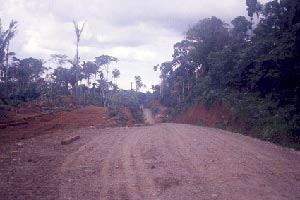 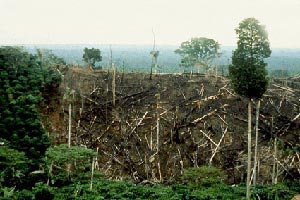
It is no secret any
more: apart from some nature reserves the whole Amazonian forest
is threatened and with it all tropical forests on earth
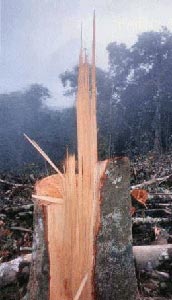 Though
we know, and repeat and rehash that this is an immeasurable catastrophe,
a tragedy for biodiversity, even a serious threat on the survival
of humankind, things do not change: destruction extends year after
year. Today, in Brazil only, one million hectares of forest is destroyed
every year to give way to soya crops! Though
we know, and repeat and rehash that this is an immeasurable catastrophe,
a tragedy for biodiversity, even a serious threat on the survival
of humankind, things do not change: destruction extends year after
year. Today, in Brazil only, one million hectares of forest is destroyed
every year to give way to soya crops!
The peoples who live in the forest were first affected by such unprecedented
destruction. Many just disappeared; most went through a terrifying
social and cultural reshuffling. Those who are still around are
aware of of what is expecting them, they fight for their survival
and their dignity.
Oil exploitation
in Ecuador
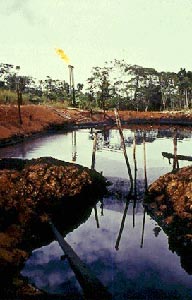 So
as to develop Amazonian oil exploitation the Ecuador government
borrowed billions of dollars from abroad, thus increasing the country’s
debt in scary proportions. So
as to develop Amazonian oil exploitation the Ecuador government
borrowed billions of dollars from abroad, thus increasing the country’s
debt in scary proportions.
Caught in a vicious circle, until the audit of external debts that
is being carried out, the only way it could pay back was by further
increasing oil exploitation, which meant going over the top.
1,500,000 hectares of forests are already exploited.
500 kms of roads have been laid for 400 pumping rigs that produce
17 millions litres of unprocessed toxic waste every day. These are
disposed of into opencut basins that overflow with tropical rains
and spread into the forest.
All life has disappeared from some rivers.
Indian people who lived on those territories were killed off by
the flu, breathing disorders, cancers, and neurological disorders.
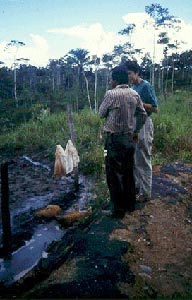 In
1995 Ecuador opened ten new 200,000 hectare parcels to exploitation,
including the territory on which the Kichwa people of Sarayaku live.
Some of these are located in areas that the UNESCO MAB programme
claimed as biosphere reserve. In
1995 Ecuador opened ten new 200,000 hectare parcels to exploitation,
including the territory on which the Kichwa people of Sarayaku live.
Some of these are located in areas that the UNESCO MAB programme
claimed as biosphere reserve.
Ecuador oil reserves could be exhausted within 15 years, with the
oil companies leaving an ecological disaster and a desperate predicament
for some 200,000 inhabitants.
In the 1960s the indigenous peoples of Ecuadorian Amazonia to the
north of the country experienced what it meant for oil companies
to invade their territories.
Given their contempt for both people and forest they soon created
an unprecedented ecological disaster: so much oil and residues leaked
into the streams and lagoons that it amounted to several times the
Exxon Valdez shipwreck.
Colonizers brought with them the use of narcotics, corruption and
prostitution. Exhausted and physically wrecked Indian people had
to leave their lands and join the shambles of violent cityslums.
The threat of oil on Sarayaku
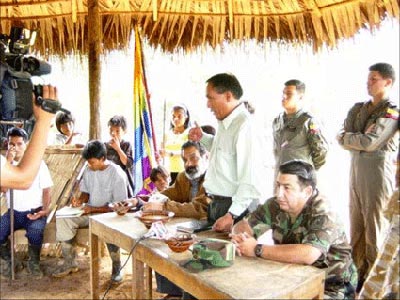
Today the Indian peoples in the south of the country, among whom
the Kichwa people of Sarayaku, have united to oppose such issue.
Sarayaku has been noticed for its steadfastness over the past ten
years, which have been most trying on its 1,200 members. The various
episodes in their struggle could fill a thick volume (threats, corruption,
tortures, military occupation, etc.)
In 2003 600 workers of an oil company protected by 400 armed soldiers
illegally invaded the territory of Sarayaku to carry out seismic
operations. For several months they buried hundreds of kilos of
explosives.
Sarayaku opposed a non-violent but determined resistance: Web campaigns,
international petitions, support by organizations such as Greenpeace
and Amnesty International, peace camps, and a lawsuit to be processed
by the International Court for Indigenous Human rights against the
State of Ecuador for violation of its constitution.
The International Court for Indigenous Human rights deemed the case
receivable and the oil company was invited to withdraw shortly before
it ignited its explosives. A major lawsuit is in process. A victory
for Sarayaku would be an unprecedented push forward for indigenous
peoples, a legal precedent that would benefit all American indigenous
peoples.
‘Frontière de Vie’ is another approach next to
other forms of support to arouse some international awareness. Analyzing
their current situation led the Sarayaku Indians to add ‘Fontière
de vie’ to the means they can already rely on in their megal
and mediatic struggle. Neither the government nor the compagnies
are about to give up.
|
|
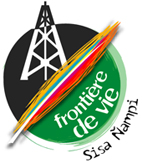


 Though
we know, and repeat and rehash that this is an immeasurable catastrophe,
a tragedy for biodiversity, even a serious threat on the survival
of humankind, things do not change: destruction extends year after
year. Today, in Brazil only, one million hectares of forest is destroyed
every year to give way to soya crops!
Though
we know, and repeat and rehash that this is an immeasurable catastrophe,
a tragedy for biodiversity, even a serious threat on the survival
of humankind, things do not change: destruction extends year after
year. Today, in Brazil only, one million hectares of forest is destroyed
every year to give way to soya crops! So
as to develop Amazonian oil exploitation the Ecuador government
borrowed billions of dollars from abroad, thus increasing the country’s
debt in scary proportions.
So
as to develop Amazonian oil exploitation the Ecuador government
borrowed billions of dollars from abroad, thus increasing the country’s
debt in scary proportions.  In
1995 Ecuador opened ten new 200,000 hectare parcels to exploitation,
including the territory on which the Kichwa people of Sarayaku live.
Some of these are located in areas that the UNESCO MAB programme
claimed as biosphere reserve.
In
1995 Ecuador opened ten new 200,000 hectare parcels to exploitation,
including the territory on which the Kichwa people of Sarayaku live.
Some of these are located in areas that the UNESCO MAB programme
claimed as biosphere reserve.